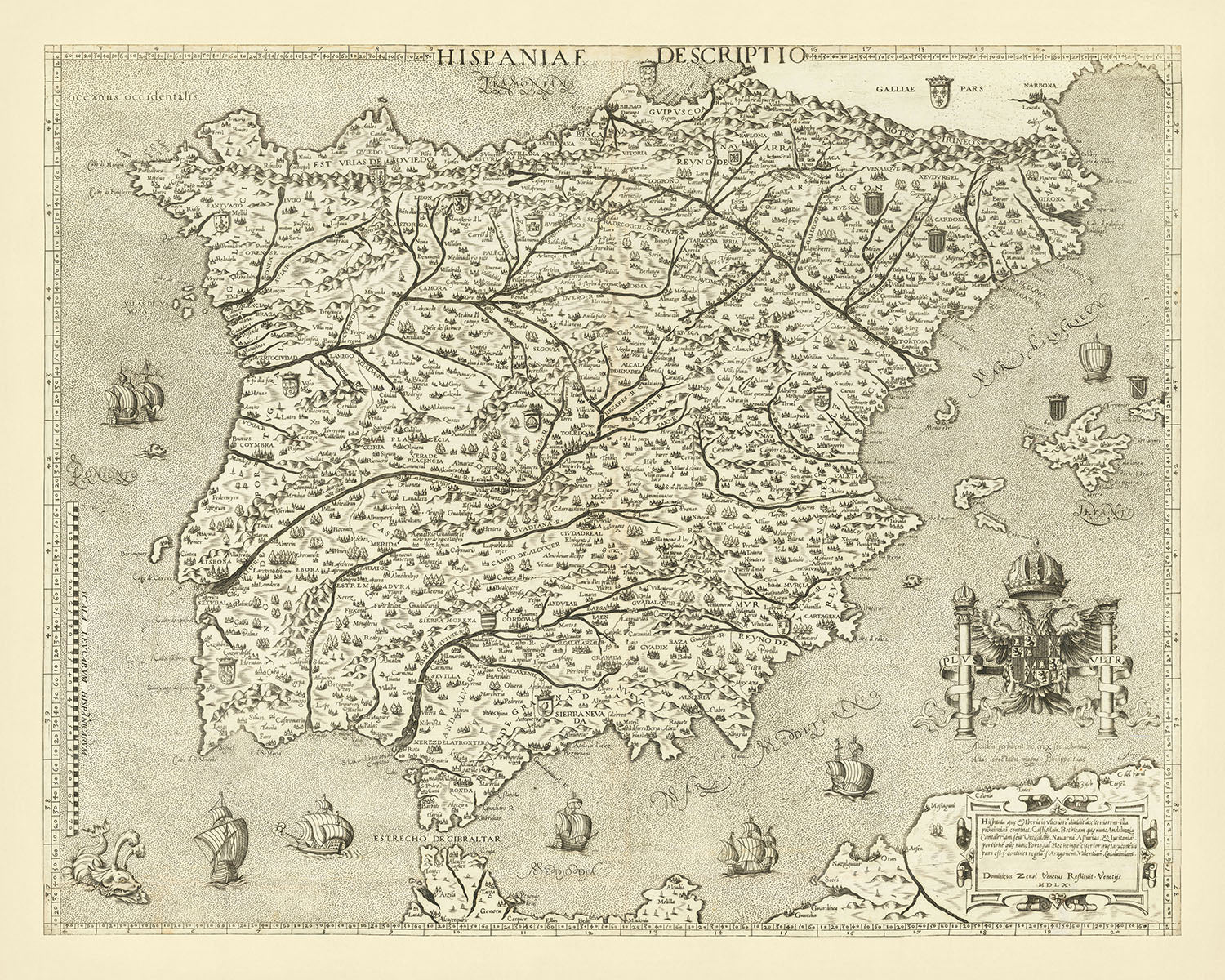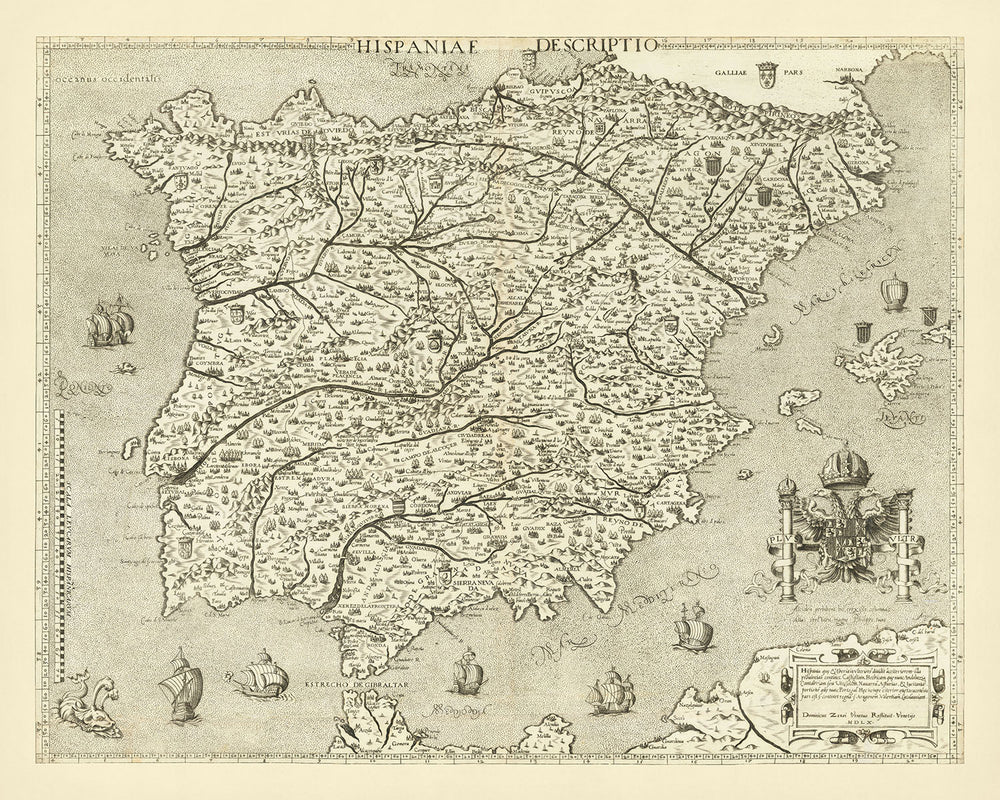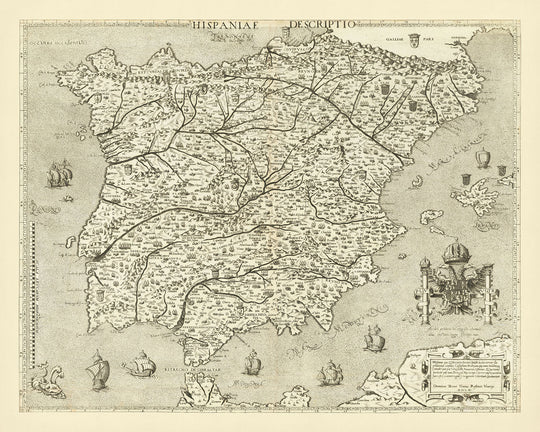- Handmade locally. No import duty or tax
- FREE Delivery by Christmas
- Love it or your money back (90 days)
- Questions? WhatsApp me any time
Own a piece of history
5,000+ 5 star reviews


Embark on a journey through time with the exquisite "Hispaniae descriptio," a masterpiece of cartography crafted by the renowned Domenico Zenoi in 1560. This rare and beautifully engraved map not only captures the essence of the Iberian Peninsula during the zenith of the Renaissance but also showcases the remarkable talents of Zenoi, a luminary of the illustrious Lafreri school of mapmaking. Originating from Venice, a hub of scientific and artistic innovation, this map reflects the advanced cartographic techniques of its era, offering a window into the geographical understanding of 16th-century Europe. The detailed depiction of Spain, Portugal, and surrounding regions, including parts of France and Italy, is complemented by the political and physical geography of the time, making it a treasure trove of historical insights.
Domenico Zenoi's meticulous craftsmanship is evident in every aspect of the "Hispaniae descriptio." The map is adorned with decorative elements that were characteristic of the period, including small territorial coats of arms, eight sailing ships, and three mythical sea monsters, adding a layer of visual intrigue. The pictorial representations of cities and mountainous areas bring the landscape of the Iberian Peninsula to life, while the inclusion of the Pillars of Hercules and the coat of arms of the Spanish monarchy imbues the map with a sense of national pride and historical significance. These features not only enhance the map's aesthetic appeal but also provide valuable insights into the geopolitical landscape of 16th-century Europe.
Zenoi's map is a testament to the rich cartographic history of the Iberian Peninsula, drawing on the work of predecessors such as Vicko Paletin, Hieronymous Cock, and Vincenzo Luchini. By incorporating and building upon their earlier efforts, Zenoi created a map that was not only more detailed and accurate but also a work of art in its own right. The "Hispaniae descriptio" stands as a culmination of the knowledge and artistic skill of its time, making it an invaluable resource for historians, cartographers, and collectors alike.
The geographical features depicted on the map, including the Strait of Gibraltar, the Ebro, Duero, Tajo, Guadiana, and Guadalquivir rivers, as well as the Pyrenees, Cantabrian, Sistema Central, and Sierra Morena mountains, offer a comprehensive overview of the Iberian Peninsula's diverse landscapes. The detailed representation of cities and towns, from Lisbon and Sevilla to Valencia and Barcelona, provides a glimpse into the urban centers that played pivotal roles in the political, economic, and cultural life of Spain and Portugal during the Renaissance.
In essence, the "Hispaniae descriptio" by Domenico Zenoi is not merely a map; it is a historical document that captures the spirit of an era when cartography was both a science and an art. It invites modern viewers to explore the rich tapestry of the Iberian Peninsula's past, offering insights into the geographical knowledge, artistic sensibilities, and political realities of 16th-century Europe. This map is a must-have for connoisseurs of history, art, and cartography, promising to be a centerpiece of any collection and a topic of conversation for generations to come.
Cities and towns on this map
- Lisboa (Lisbon)
- Sevilla (Seville)
- Valencia
- Barcelona
- Granada
- Toledo
- Malaga
- Murcia
- Cadiz
- Zaragoza (Saragossa)
- Palma (Majorca)
- Valladolid
- Bilbao
- Oviedo
- Santiago de Compostela
- Cartagena
- Almeria
- Alicante
- Badajoz
- Tarragona
- Cordoba
- Burgos
- Salamanca
- Leon
- Huelva
- Jaen
- Jerez de la Frontera
- Pamplona
- Logrono
- Santander
- Albacete
- Alcala de Henares
- Avila
- Caceres
- Castellon de la Plana
- Ciudad Real
- Cuenca
- Gerona
- Guadalajara
- Huesca
- Lerida
- Lugo
- Orense
- Palencia
- Pontevedra
- Soria
- Teruel
- Zamora
Notable Features & Landmarks
- Coat of arms of the Spanish monarchy
- Pillars of Hercules
- 8 sailing ships
- 3 sea monsters
- Pictorial depictions of cities and mountainous areas
- Names of the winds across the seas: Tramontana, Mediodia, Levante, and Poniente
- Small territorial coats of arms
- Strait of Gibraltar
- Ebro River
- Duero River
- Tajo River
- Guadiana River
- Guadalquivir River
- Pyrenees mountains
- Cantabrian mountains
- Sistema Central mountains
- Sierra Morena mountains
- Iberian Peninsula
- Mediterranean Sea
- Atlantic Ocean
- Bay of Biscay
Historical and design context
- Title: Hispaniae descriptio
- Date: 1560
- Mapmaker/Publisher: Domenico Zenoi
- Topics/Themes: Political and physical geography of the Iberian Peninsula
- Countries/Regions Shown: Spain, Portugal, Andorra, Gibraltar, parts of France and Italy
- Design/Style: Lafreri school, decorative elements include small territorial coats of arms, eight sailing ships, and three sea monsters. Cities and mountainous areas are depicted pictorially.
- Historical Significance: Reflects the advanced cartographic techniques of the 16th century. The map is based on Vicko Paletin's 1551 woodcut map, later copied by Hieronymous Cock in 1553 and Vincenzo Luchini in 1559.
Please double check the images to make sure that a specific town or place is shown on this map. You can also get in touch and ask us to check the map for you.
This map looks great at every size, but I always recommend going for a larger size if you have space. That way you can easily make out all of the details.
This map looks amazing at sizes all the way up to 90in (230cm). If you are looking for a larger map, please get in touch.
The model in the listing images is holding the 16x20in (40x50cm) version of this map.
The fifth listing image shows an example of my map personalisation service.
If you’re looking for something slightly different, check out my collection of the best old maps to see if something else catches your eye.
Please contact me to check if a certain location, landmark or feature is shown on this map.
This would make a wonderful birthday, Christmas, Father's Day, work leaving, anniversary or housewarming gift for someone from the areas covered by this map.
This map is available as a giclée print on acid free archival matte paper, or you can buy it framed. The frame is a nice, simple black frame that suits most aesthetics. Please get in touch if you'd like a different frame colour or material. My frames are glazed with super-clear museum-grade acrylic (perspex/acrylite), which is significantly less reflective than glass, safer, and will always arrive in perfect condition.
This map is also available as a float framed canvas, sometimes known as a shadow gap framed canvas or canvas floater. The map is printed on artist's cotton canvas and then stretched over a handmade box frame. We then "float" the canvas inside a wooden frame, which is available in a range of colours (black, dark brown, oak, antique gold and white). This is a wonderful way to present a map without glazing in front. See some examples of float framed canvas maps and explore the differences between my different finishes.
For something truly unique, this map is also available in "Unique 3D", our trademarked process that dramatically transforms the map so that it has a wonderful sense of depth. We combine the original map with detailed topography and elevation data, so that mountains and the terrain really "pop". For more info and examples of 3D maps, check my Unique 3D page.
For most orders, delivery time is about 3 working days. Personalised and customised products take longer, as I have to do the personalisation and send it to you for approval, which usually takes 1 or 2 days.
Please note that very large framed orders usually take longer to make and deliver.
If you need your order to arrive by a certain date, please contact me before you order so that we can find the best way of making sure you get your order in time.
I print and frame maps and artwork in 23 countries around the world. This means your order will be made locally, which cuts down on delivery time and ensures that it won't be damaged during delivery. You'll never pay customs or import duty, and we'll put less CO2 into the air.
All of my maps and art prints are well packaged and sent in a rugged tube if unframed, or surrounded by foam if framed.
I try to send out all orders within 1 or 2 days of receiving your order, though some products (like face masks, mugs and tote bags) can take longer to make.
If you select Express Delivery at checkout your order we will prioritise your order and send it out by 1-day courier (Fedex, DHL, UPS, Parcelforce).
Next Day delivery is also available in some countries (US, UK, Singapore, UAE) but please try to order early in the day so that we can get it sent out on time.
My standard frame is a gallery style black ash hardwood frame. It is simple and quite modern looking. My standard frame is around 20mm (0.8in) wide.
I use super-clear acrylic (perspex/acrylite) for the frame glass. It's lighter and safer than glass - and it looks better, as the reflectivity is lower.
Six standard frame colours are available for free (black, dark brown, dark grey, oak, white and antique gold). Custom framing and mounting/matting is available if you're looking for something else.
Most maps, art and illustrations are also available as a framed canvas. We use matte (not shiny) cotton canvas, stretch it over a sustainably sourced box wood frame, and then 'float' the piece within a wood frame. The end result is quite beautiful, and there's no glazing to get in the way.
All frames are provided "ready to hang", with either a string or brackets on the back. Very large frames will have heavy duty hanging plates and/or a mounting baton. If you have any questions, please get in touch.
See some examples of my framed maps and framed canvas maps.
Alternatively, I can also supply old maps and artwork on canvas, foam board, cotton rag and other materials.
If you want to frame your map or artwork yourself, please read my size guide first.
My maps are extremely high quality reproductions of original maps.
I source original, rare maps from libraries, auction houses and private collections around the world, restore them at my London workshop, and then use specialist giclée inks and printers to create beautiful maps that look even better than the original.
My maps are printed on acid-free archival matte (not glossy) paper that feels very high quality and almost like card. In technical terms the paper weight/thickness is 10mil/200gsm. It's perfect for framing.
I print with Epson ultrachrome giclée UV fade resistant pigment inks - some of the best inks you can find.
I can also make maps on canvas, cotton rag and other exotic materials.
Learn more about The Unique Maps Co.
Map personalisation
If you're looking for the perfect anniversary or housewarming gift, I can personalise your map to make it truly unique. For example, I can add a short message, or highlight an important location, or add your family's coat of arms.
The options are almost infinite. Please see my map personalisation page for some wonderful examples of what's possible.
To order a personalised map, select "personalise your map" before adding it to your basket.
Get in touch if you're looking for more complex customisations and personalisations.
Map ageing
I have been asked hundreds of times over the years by customers if they could buy a map that looks even older.
Well, now you can, by selecting Aged before you add a map to your basket.
All the product photos you see on this page show the map in its Original form. This is what the map looks like today.
If you select Aged, I will age your map by hand, using a special and unique process developed through years of studying old maps, talking to researchers to understand the chemistry of aging paper, and of course... lots of practice!
If you're unsure, stick to the Original colour of the map. If you want something a bit darker and older looking, go for Aged.
If you are not happy with your order for any reason, contact me and I'll get it fixed ASAP, free of charge. Please see my returns and refund policy for more information.
I am very confident you will like your restored map or art print. I have been doing this since 1984. I'm a 5-star Etsy seller. I have sold tens of thousands of maps and art prints and have over 5,000 real 5-star reviews. My work has been featured in interior design magazines, on the BBC, and on the walls of dozens of 5-star hotels.
I use a unique process to restore maps and artwork that is massively time consuming and labour intensive. Hunting down the original maps and illustrations can take months. I use state of the art and eye-wateringly expensive technology to scan and restore them. As a result, I guarantee my maps and art prints are a cut above the rest. I stand by my products and will always make sure you're 100% happy with what you receive.
Almost all of my maps and art prints look amazing at large sizes (200cm, 6.5ft+) and I can frame and deliver them to you as well, via special oversized courier. Contact me to discuss your specific needs.
Or try searching for something!















































